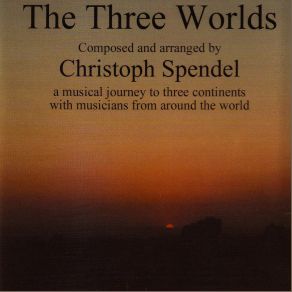The Three Worlds
Download links and information about The Three Worlds by Christoph Spendel. This album was released in 2010 and it belongs to Jazz genres. It contains 11 tracks with total duration of 01:09:24 minutes.

|
|
|---|---|
| Artist: | Christoph Spendel |
| Release date: | 2010 |
| Genre: | Jazz |
| Tracks: | 11 |
| Duration: | 01:09:24 |
| Buy it NOW at: | |
| Buy on iTunes $9.99 | |
| Buy on Amazon $8.99 | |
Tracks
[Edit]| No. | Title | Length |
|---|---|---|
| 1. | The Three Worlds - Overture | 2:06 |
| 2. | Le 'at Le 'at (slowly slowly) | 8:32 |
| 3. | Sharav (hot wind) | 5:40 |
| 4. | Midbar (desert) | 9:08 |
| 5. | Jerusalem | 7:24 |
| 6. | New York (home of contrasts) | 7:20 |
| 7. | Moon over Tel Aviv | 7:49 |
| 8. | Dance of the Saints | 6:11 |
| 9. | Warrior for Peace (in memory of Mr. Yitzhak Rabin) | 7:04 |
| 10. | Shoham (storm) | 6:05 |
| 11. | The Three Worlds - Conclusion - The Final Meditation | 2:05 |
Details
[Edit]The Three Worlds is a literal construct as well as a metaphorical one for composer and all-over-the-place pianist and improviser Christoph Spendel. Spendel had a vision for a large-scale work that would incorporate musicians from many different cultures, who would all lend their particular contributions to a work of undetermined length and/or genre. He took a series of solo piano recordings made in his Ratigen studio to Tel Aviv, where he was teaching and performing. In Israel he played the tapes for a number of musicians, who all looked through his arrangements and added their own signatures to the master. Spendel then went on to New York for a series of gigs and lectures and recruited people like Leni Stern, Urszula Dudziak, Mark Smulian, and others to blend in with their own voices and instruments. The result is a massive work that traverses jazz, pop, classical, and world music boundaries to erect a trilevel world where spoken language no longer matters, and what does is the transmission of voice and emotion by sound alone — musical sound. Folk elements are layered in via samplers as well as scripted parts for instruments, and solos divide one part of the "old world" up into three that are in unity, triune in their aims and goals but different in approaches. There is so much going on in this hour-plus of music that it is difficult to separate any of it out — except to say that, while this would and should be called jazz due to the theme/solo/variation/theme format in much of it, it doesn't feel like any jazz you've ever heard. However, it does resonate deep in the heart with depth and dimension, because this is a work that virtually can be taken in by the whole world. There is something here for everyone —except for the most philistine — to hear in their own languages and according to their own aesthetic sensibilities. This is truly a jazz symphony with no excesses, comprised of many colors and textures. Bravo.